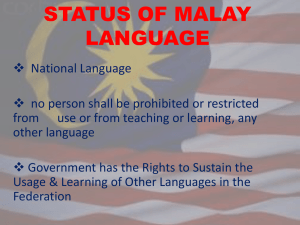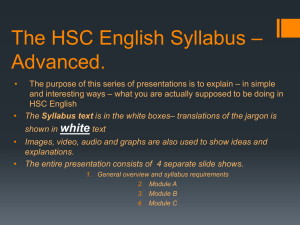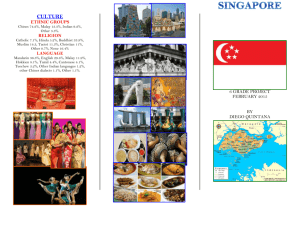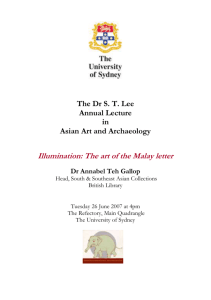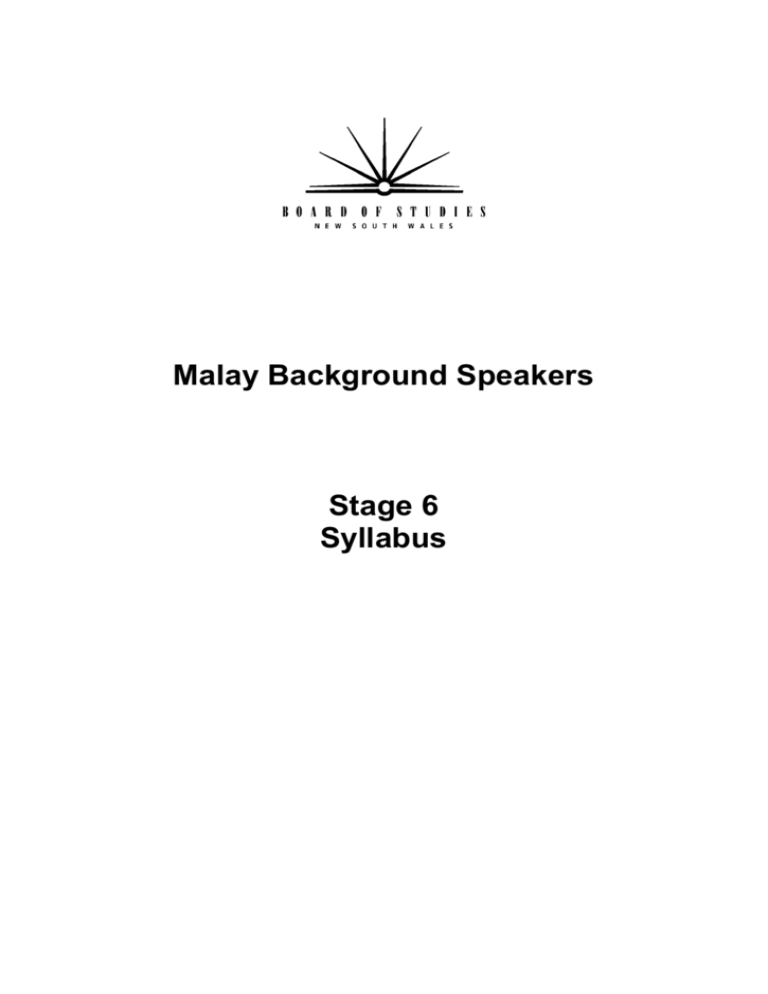
Malay Background Speakers
Stage 6
Syllabus
Original Published version updated
Updated June 2008 – BOS 29/08, Vol 17 No 3
June 2009 – Assessment and Reporting information updated
© 2009 Copyright Board of Studies NSW for and on behalf of the Crown in right of the State of New
South Wales.
This document contains Material prepared by the Board of Studies NSW for and on behalf of the
State of New South Wales. The Material is protected by Crown copyright.
All rights reserved. No part of the Material may be reproduced in Australia or in any other country by
any process, electronic or otherwise, in any material form or transmitted to any other person or
stored electronically in any form without the prior written permission of the Board of Studies NSW,
except as permitted by the Copyright Act 1968. School students in NSW and teachers in schools in
NSW may copy reasonable portions of the Material for the purposes of bona fide research or study.
When you access the Material you agree:
•
•
•
•
•
•
to use the Material for information purposes only;
to reproduce a single copy for personal bona fide study use only and not to reproduce any major
extract or the entire Material without the prior permission of the Board of Studies NSW;
to acknowledge that the Material is provided by the Board of Studies NSW.
not to make any charge for providing the Material or any part of the Material to another person or
in any way make commercial use of the Material without the prior written consent of the Board of
Studies NSW and payment of the appropriate copyright fee;
to include this copyright notice in any copy made;
not to modify the Material or any part of the Material without the express prior written permission
of the Board of Studies NSW.
The Material may contain third party copyright materials such as photos, diagrams, quotations,
cartoons and artworks. These materials are protected by Australian and international copyright laws
and may not be reproduced or transmitted in any format without the copyright owner’s specific
permission. Unauthorised reproduction, transmission or commercial use of such copyright materials
may result in prosecution.
The Board of Studies has made all reasonable attempts to locate owners of third party copyright
material and invites anyone from whom permission has not been sought to contact the Copyright
Officer, ph (02) 9367 8289, fax (02) 9279 1482.
Published by Board of Studies NSW
GPO Box 5300
Sydney 2001
Australia
Tel: (02) 9367 8111
Fax: (02) 9367 8484
Internet: http://www.boardofstudies.nsw.edu.au
ISBN 0 7313 4548 7
2009389
Contents
1
The Higher School Certificate Program of Study ................................................... 5
2
Introduction to Malay in the Stage 6 Curriculum .................................................... 6
2.1
The Language ....................................................................................................... 6
2.2
Description of Target Group................................................................................... 6
2.3
Rationale ............................................................................................................... 6
3
Continuum of Learning for Malay Stage 6 Students .............................................. 8
4
Aims .................................................................................................................... 10
5
Objectives ............................................................................................................ 10
6
Course Structure ................................................................................................. 11
7
Objectives and Outcomes ................................................................................... 12
8
9
7.1
Table of Objectives and Outcomes .......................................................................12
7.2
Key Competencies ...............................................................................................14
Content ................................................................................................................ 15
8.1
Themes and Contemporary Issues .......................................................................15
8.2
Tasks ....................................................................................................................16
8.3
Texts and Text Types ...........................................................................................16
8.4
Dictionaries ...........................................................................................................17
8.5
Grammar ..............................................................................................................17
Course Requirements .......................................................................................... 23
9.1
HSC Course Prescriptions ....................................................................................23
10 Post-school Opportunities ................................................................................... 24
11 Assessment and Reporting ................................................................................. 25
BLANK PAGE
Malay Background Speakers Stage 6 Syllabus
1
The Higher School Certificate Program of Study
The purpose of the Higher School Certificate program of study is to:
• provide a curriculum structure which encourages students to complete
secondary education;
• foster the intellectual, social and moral development of students, in
particular developing their:
knowledge, skills, understanding and attitudes in the fields of study they
choose
capacity to manage their own learning
desire to continue learning in formal or informal settings after school
capacity to work together with others
respect for the cultural diversity of Australian society;
• provide a flexible structure within which students can prepare for:
further education and training
employment
full and active participation as citizens;
• provide formal assessment and certification of students’ achievements;
• provide a context within which schools also have the opportunity to foster
students’ physical and spiritual development.
5
Malay Background Speakers Stage 6 Syllabus
2
2.1
Introduction to Malay in the Stage 6 Curriculum
The Language
The language to be studied and assessed is the standard version of Malay
(Bahasa Melayu baku) and its spoken variety, as used in the Malay
archipelago.
The Malay language is rich in colloquial and idiomatic expressions and literary
allusions, and this is reflected in the content of this syllabus.
In contemporary Malaysian society, Malay is considered to be the standard
language of communication by all the inhabitants of the Malay archipelago,
which encompasses a diverse range of cultures, dialects, and religions.
Although the different dialects are recognised as belonging to the Malay
archipelago, they do not form part of this syllabus.
Although there is both formal and informal speech, the written version of the
language must be formal. In letter-writing, formal, traditional conventions of
the language must be used. The use of Jawi script is encouraged, but is
optional. Jawi is widely used in the northern and eastern states of Malaysia,
notably Kelantan and Terengganu, as well as in Brunei. The historical,
cultural, and religious significance of Jawi could receive appropriate
recognition in the teaching of a program based on this syllabus.
2.2
Description of Target Group
The Malay Background Speakers Level Syllabus is designed for students with
a cultural and linguistic background in Malay. The target group for this
syllabus is almost exclusively students with a Malaysian background who are
studying in Malaysia.
This syllabus also serves to meet the needs of students wishing to pursue
their education in Australia.
The cohort will range from students who were born and reside in a country
where Malay is a medium of instruction to students who have recently arrived
in Australia.
2.3
Rationale
The study of Malay contributes to the overall education of students,
particularly in the areas of communication, cross-cultural understanding,
literacy, cognitive development, and general knowledge.
The study promotes understanding of different attitudes and values within
Malay-speaking and Australian communities, and in Malay-speaking
communities in Australia (Christmas Island, Cocos (Keeling) Islands).
6
Malay Background Speakers Stage 6 Syllabus
Malay is also one of the languages of Indonesia, Brunei, Singapore, and
southern Thailand.
The Malay language is significant because of the:
•
dominant political, economic, and cultural role that the language (as Malay
and Indonesian) plays in the geographical region to which Australia
belongs;
•
fact that the language is a unifying force in the multicultural societies of the
Malay archipelago;
•
vital part played in the modern world by the religious and cultural heritage
that the Malay archipelago shares with many other regions in the world;
•
notable connection with the Malay language and culture in the north and
north-western parts of Australia.
In its development the language, as used in the Malay archipelago, is closely
linked with socio-political, historical, and cultural factors that impact on the
traditions and lives of the Malaysian population. An awareness of these
factors, which have shaped and continue to shape the multiracial Malaysian
society, is essential in a program based on this syllabus. In order to develop
a depth of competence and maturity in using communicative, cognitive,
learning, and social skills to meet the objectives of this syllabus, including an
understanding of the subtleties of the language, there is a particular emphasis
on literature and culture.
The ability to communicate in Malay may, in conjunction with other skills,
increase students’ vocational opportunities in the areas of trade, business,
banking, defence, diplomacy, immigration, education, journalism, law,
engineering, tourism, and the arts.
7
Malay Background Speakers Stage 6 Syllabus
3
Continuum of Learning for Malay Stage 6 Students
Stages 1–3
Human Society and Its Environment
Stages 4–5
Languages (mandatory 100 hours)
Stage 5
Languages elective courses
Stage 6
Malay Background Speakers
Preliminary
HSC
Workplace
University
8
TAFE
Other
Malay Background Speakers Stage 6 Syllabus
The New South Wales curriculum provides opportunities for students to study
a language or languages from Early Stage 1 through to Stage 6.
In the K–6 (Stages 1–3) Human Society and Its Environment key learning
area, students develop an awareness of languages and may learn about the
world through the study of a language.
In Years 7–10, a language is a mandatory component of the School
Certificate, with students being required to complete 100 hours of language
study.
Stage 6 offers students the opportunity to continue the study of a language at
Background Speakers level. Students may also begin the study of a language
in Stage 6.
9
Malay Background Speakers Stage 6 Syllabus
4
Aims
The aims of the syllabus are to develop the student’s:
•
ability to use Malay to communicate with others
•
understanding and appreciation of the cultural contexts in which Malay is
used
•
ability to reflect on his or her own and other culture(s)
•
understanding of language as a system
•
ability to make connections between Malay and English, and/or other
languages
•
cognitive, learning, and social skills
•
potential to apply Malay to work, further study, training or leisure.
5
Objectives
The student should be able to achieve the following objectives:
Objective 1 — exchange information, opinions and ideas in Malay
Objective 2 — express ideas through the production of original texts in Malay
Objective 3 — analyse, evaluate, and respond to texts that are in Malay
Objective 4 — understand aspects of the language and culture of Malayspeaking communities.
Meeting these objectives will involve using the skills of listening, speaking,
reading, and writing, either individually or in combination, and being able to
move between Malay and English.
10
Malay Background Speakers Stage 6 Syllabus
6
Course Structure
The Preliminary Course (120 indicative hours)
The Preliminary course is intended to provide the student with the
opportunities to develop his or her communication skills, knowledge and
understanding of the language through the study of a range of authentic
Malay texts. In the Preliminary course, a number of prescribed themes and
contemporary issues will be studied. Through these, the student will develop
the skills needed to study the prescribed texts for the HSC course.
The HSC Course (120 indicative hours)
In addition to the development of language and communication skills, the
HSC course is structured to provide the student with opportunities to explore
the prescribed themes and contemporary issues further by analysing,
evaluating and responding to prescribed texts.
11
Malay Background Speakers Stage 6 Syllabus
7
Objectives and Outcomes
The outcomes listed below represent the knowledge, skills and
understanding, that the student will achieve by the end of the HSC course
based on this syllabus. The outcomes have been linked to one objective but
may derive from more than one. The degree to which the student achieves
these outcomes will be reported in the performance scale.
7.1
Table of Objectives and Outcomes
Objectives
Outcomes
The student should be
able to:
1. exchange information,
opinions, and ideas in
Malay
1.1 convey information, opinions, ideas, feelings,
and attitudes accurately and appropriately.
1.2 exchange and justify opinions and ideas.
1.3 use appropriate features of language for a
variety of contexts, purposes, and audiences.
1.4 use strategies to sustain communication.
2. express ideas through
the production of
original texts in Malay
2.1 sequence and structure information, opinions,
ideas, feelings, and attitudes logically and
coherently.
2.2 demonstrate control of appropriate language
structures and vocabulary.
2.3 produce texts that are persuasive, creative,
and discursive.
2.4 produce texts appropriate to context, purpose,
and audience.
2.5 use a variety of features to put forward and
defend opinions and convey meaning, through
being able to recognise and use the subtleties
and nuances of literary allusion, and
incorporate a wide range of vocabulary and
expressions.
12
Malay Background Speakers Stage 6 Syllabus
3. analyse, evaluate, and
respond to texts that
are in Malay
3.1 present information in a different form and/or
for a different audience.
3.2 explain the significance of context in
conveying meaning.
3.3 identify, discuss, and analyse main points and
detailed items of specific information.
3.4 summarise and interpret information and
ideas.
3.5 compare and contrast aspects of texts.
3.6 infer points of view, values, attitudes, and
emotions from features of language in texts.
3.7 respond to fiction and non-fiction texts
personally and critically.
3.8 compose an argument supported by textual
references.
4. understand aspects of
the language and
culture of Malayspeaking communities
4.1 demonstrate knowledge of appropriate
language structures and semantic relations,
and language origins.
4.2 examine and discuss sociocultural elements in
texts.
4.3 recognise and employ language appropriate
to different sociocultural contexts, and
appreciate indirect and culturally appropriate
ways of addressing others, including
protocols.
4.4 appreciate and explore the way that
analogies, imagery, symbolism, hidden
meanings, metaphors, veiled sayings,
nuances, similes, and other stylistic features
affect the tone and mood of spoken texts and
provide insight into the speaker’s motives and
opinions.
13
Malay Background Speakers Stage 6 Syllabus
7.2
Key Competencies
The Malay Stage 6 Background Speakers course provides a powerful context
within which to develop general competencies considered essential for the
acquisition of effective, higher-order thinking skills necessary for further
education, work, and everyday life.
Key competencies are embedded in the Malay Background Speakers Stage 6
Syllabus to enhance student learning. The key competencies of
communicating ideas and information and collecting, analysing and
organising information reflect core skills in language learning and are
explicit in the objectives and outcomes of the syllabus. The other key
competencies are developed through the methodology of the syllabus and
through classroom pedagogy. Students interact with each other, and through
this interaction, the key competencies, planning and organising activities
and working with others and in teams, are developed. In interacting with
others via communications technology, the student will develop the key
competency of using technology. The skills associated with the analysis of
texts, such as the ability to comprehend meaning from context and using a
dictionary, contribute towards the student’s development of the key
competency solving problems.
14
Malay Background Speakers Stage 6 Syllabus
8
Content
8.1
Themes and Contemporary Issues
Themes provide a context and an organisational focus within which the
student will develop his or her knowledge of Malay, and understanding of the
cultural contexts in which Malay is used.
Themes will be studied through a range of texts, some of which may be
prescribed. The texts will enable the student to reflect on, and respond to,
aspects of language and culture of Malay-speaking communities. The student
will develop skills in exchanging, analysing, and evaluating information,
opinions, and ideas.
8.1.1 Prescribed Themes
There are four prescribed themes, two to be studied each year:
2008
•
Malaysia and the world (Year 12)
•
socioeconomic change and development (Year 12)
•
women in society (Year 11)
•
cultural change (Year 11)
2009 and until further notice
•
Malaysia and the world (Year 11)
•
socioeconomic change and development (Year 12)
•
women in society (Year 11)
•
cultural change (Year 12)
8.1.2
Prescribed Contemporary Issues
The themes have a number of prescribed contemporary issues. The
placement of issues under one or more of the themes is intended to provide a
particular perspective or perspectives for each of the issues. For each theme
studied, the student will be required to study at least two works from the
required reading list in the ‘Resources’ section.
Theme
Contemporary Issues
•
•
national perspectives (national identity)
•
international perspectives (cross-cultural
contacts)
socioeconomic change and
development
•
impact of information technology
•
impact of development on the environment
women in society
•
impact of the changing role of women on the
family
•
position of women in Malaysian society
•
influence of Western culture
•
youth and their identity in society
•
•
•
Malaysia and the world
cultural change
15
Malay Background Speakers Stage 6 Syllabus
8.2
Tasks
This syllabus recognises the importance of tasks as an organising principle in
structuring a program that allows the student to work towards meeting the
objectives and outcomes.
Tasks, which are broadly defined as opportunities for the purposeful use of
language, must be selected and designed so that the student can develop
and demonstrate knowledge, skills, and understanding at increasingly
complex levels.
Tasks can be described as having four elements:
•
a purpose (a reason for undertaking the task that goes beyond the practice
of the language for its own sake)
•
a context (this may be real, simulated, or imaginary, and include aspects
such as where, when, who is involved)
•
a process (thinking, problem-solving, creating)
•
a product (a result that can be described in terms of achievement of the
purpose of the task and in the student’s overall cognitive development).
8.3
Texts and Text Types
The term ‘text’ refers to any form of communication – spoken, written, or
visual, or combinations of these. Texts are sometimes usefully grouped as
‘text types’. For example, texts such as a letter, an interview, or a report,
share a certain generic structure that is not arbitrary, but reflects the purpose
for which the text has been produced. Each text type has defining
characteristics of which the student should be made aware.
The student will read, listen to, and view a range of texts and text types in
Malay relevant to the prescribed themes and contemporary issues. English
language texts may also provide a perspective on the themes and
contemporary issues being explored. However, most of the texts studied must
be in Malay. In addition, the student will be expected to construct a range of
texts appropriate to a variety of contexts, purposes, and audiences.
The student will analyse and evaluate texts from linguistic perspectives
(language forms and features, structure), and cultural perspectives (thematic,
contextual, social, and political), and consider the relationships between the
two. The student will analyse and evaluate the way texts convey their
message and have an impact on their audience.
In this way, the student will develop skills in listening, speaking, reading, and
writing. The student will also develop skills in critical literacy by reflecting on
his or her own and other cultures, and by making connections between Malay
and English, and/or other languages.
16
Malay Background Speakers Stage 6 Syllabus
The student will be expected to be familiar with the following text types. Text
types indicated with an asterisk (*) are those that the student may be
expected to produce in the external examination. In their teaching and
learning program, teachers may introduce the student to a wider range of text
types than are presented here.
advertisements
announcements
articles*
broadcasts
debates
descriptions
discussions*
8.4
essays*
films
interviews
journal entries*
letters*
narrative accounts*
personal profiles
recounts
reports*
reviews*
short stories
speeches/talks*
Dictionaries
The student should be encouraged to use dictionaries. It is expected that
teachers will help students to develop the necessary skills and confidence to
use dictionaries effectively.
Students are able to use monolingual and/or bilingual print dictionaries in the
written examination. Information regarding the use of dictionaries in the HSC
examination may be found in Assessment and Reporting in Malay
Background Speakers Stage 6.
8.5
Grammar
Grammar can be described as the organisation of, and relationship between,
all the elements that constitute a language as it functions.
There are many different theories of grammar, and a number of different
approaches to its teaching and learning. The categories used below are not
intended to promote or favour any particular theory of grammar.
The student will already have acquired a significant understanding of the
function of grammar in Malay through prior knowledge or study of Malay.
Developing the student’s ability to convey meaning effectively in a range of
contexts will, however, necessarily involve extending his or her awareness of
the system of structures that underlie the language, as well as his or her
ability to apply and adapt this knowledge.
The student studying Malay in a Background Speakers course is expected to
recognise and use the following grammatical structures.
17
Malay Background Speakers Stage 6 Syllabus
Grammatical
item
Verbs
Sub-elements
Example(s)
base-word verbs
berme-, me-kan, me-i
menge-kan, memper-kan,
ke-an, teractive, passive
imperative forms
with reduplication
imitative reduplication
with markers and modifiers
with negators
with accompanying
prepositions
Nouns
base-word nouns
ke... an/ketidak-an
pepe... an/per... an,-an
-wan/-wati
keber-an
keter-an
juruke-isme
-asi
-logi
18
berlari, berenang
melukis, melihatkan, mendekati
mengetengahkan,
memperisterikan, kelihatan,
kedengaran, tertawa
belum kukenal namanya,
dipukul, sebaiknya masalah itu
dibincangkan lebih dahulu
jangan tutup pintu! buka pintu
itu!
surat-menyurat (reciprocity)
berlari-lari (repetitive, varied or
non-specific action), berlarilarian
mundar-mandir, bolak-balik,
beli-belah, hempas-pulas,
tungkus-lumus
sudah, telah, sedang, akan,
harus, dapat, boleh, suka, ingin,
mahu, lagi, kembali, saling,
hendak
tidak, belum, bukan
bergantung pada, ingat akan,
mohon maaf atas, percaya
pada, bertentangan dengan
kemanusiaan, ketidakadilan
pekerja
pertemuan, peralihan, jaminan
karyawan/wati
keberangkatan, keberkesanan
keterlanjuran
juruterbang, jurulatih
ketua, kekasih
liberalisme
modernisasi
ekologi
Malay Background Speakers Stage 6 Syllabus
Grammatical
item
Nouns (cont)
Sub-elements
Example(s)
with reduplication
with the negator
surat-surat khabar, buku-buku
(plurality, showing variety),
sayur-sayuran (showing
collectivity)
keanak-anakan (showing
diminutive), lelaki, rerumput,
tetuan
asal-usul, selok-belok, jarijemari, adat-istiadat
bukan
1st person
saya, aku, kami, kita, beta, patik
2nd person
awak, kamu, anda, engkau, kau,
kamu sekalian, anda sekalian
dia, ia, beliau, mereka, -nya
Ayah, Emak, Mak, Ibu, Bapa,
Adik, Kakak, Kak, Abang, Bang,
Saudara/i, Tuan, Puan, Encik,
Cik, Cikgu, etc, person’s name
bukan
semi-duplication
imitative reduplication
Personal
pronouns
3rd person
other terms used in the
place of pronouns
with the negator
Question markers
with other prepositions
Deictics
Quantifiers
siapa, apa, mana, mengapa,
kenapa, di mana, ke mana, dari
mana, bagaimana, berapa, -kah,
bila
daripada siapa, dengan apa,
untuk siapa
ini, itu, sini, sana, situ, begini,
begitu
cardinal numbers
collectives
indefinite terms
19
satu, dua, etc, plus eka, dwi, etc
ketiga pemain, kami berenam,
berpuluh-puluh, beramai-ramai,
ratusan
banyak, beberapa, sedikit,
semua, seluruh, segala,
separuh
Malay Background Speakers Stage 6 Syllabus
Grammatical
item
Quantifiers (cont)
Sub-elements
Example(s)
ordinal numbers
classifiers
pertama, kedua, kesepuluh
orang, buah, ekor, pucuk, helai,
butir, etc
se-, satu, suatu
through duplication, through
context, through use of
para/kaum, through use of
in/at(muslimin/at), through use
of an (tahunan)
singularity
plurality
Adjectives
base-word adjectives
me-kan with adjectival
function
ter- adjective
ke-an
compound adjectives
comparatives
with degree markers
with other modifiers
with negators
Adverbs
dengan + base
duplication of base
ber-an
20
menyenangkan
termasyhur
kebaratan
lemah-lembut, kacau-bilau,
murah hati
se- + adjective, setingginya
sama + adjective + -nya,
lebih + adjective + daripada,
yang/paling/ter- + adjective
terlalu mahal, sangat kecil, amat
penting, kurang penting, lebih
berat, paling murah
semakin dahsyat, makin sibuk
tidak sihat, belum matang
dengan teliti
diam-diam, tidak henti-hentinya,
tersedu-sedu, gila-gilaan
berdua-duaan
Malay Background Speakers Stage 6 Syllabus
Grammatical
item
Prepositions
Sub-elements
Example(s)
prepositional phrases
akan, akibat, antara, atas, bagi,
bersama, buat, dalam, dari,
dekat, dengan, di, ke, kepada,
melalui, mengenai, menurut,
oleh, pada, sama, sampai,
sebagai, sekeliling, sekitar
di bawah, ke hadapan, oleh
sebab, sampai dengan, di
antara, berkenaan dengan
Cohesive devices
(inter-sentential)
seperti, tanpa, tentang,
terhadap, padahal, di samping
itu, selain itu, sesudah itu,
begitu juga, sementara itu,
walau bagaimanapun, akan
tetapi, namun, oleh sebab itu
Conjunctions
sejak, agar, akibat, asalkan,
atau, bahawa, baik maupun,
dan, hanya, kalau, kerana,
kecuali, kemudian, ketika, jika,
lalu, melainkan, meskipun,
sambil, sampai, sebab, sebagai,
sebelum, sedangkan, sehingga,
sejak, selama, seolah-olah,
sementara, setelah, setiap,
supaya, tetapi, setiap kali, tidak
hanya... tetapi juga, untuk,
ketika, daripada... lebih baik,
tidak hanya... tetapi juga, biar,
kecuali
Interjections
wahai, syabas, wah, aduh, cis,
amboi, alamak, aduhai
Articles
sang, para, si, kalangan,
gerombolan, golongan, pihak
Particles
-kah, -lah, -tah
21
Malay Background Speakers Stage 6 Syllabus
Grammatical
item
Phrases and
sentences
Sub-elements
Example(s)
compound clauses
Mereka bangun lalu turun ke
serambi.
Ia menjawab dengan kuat serta
menepuk-nepuk dadanya.
use of ini/itu to point to a
Duit yang dihulurkannya kepada
particular referent in a noun- pengemis itu merupakan
phrase
sebahagian besar daripada gaji
bulan ini
use of adalah/ialah to mark Adelaide ialah bandar raya yang
the subject-predicate break indah.
Projek ini adalah untuk para
remaja.
use of yang as a relative
Pengarah kilang yang hanya
clause marker
mementingkan dirinya sendiri
tidak disukai para pekerjanya.
use of yang to introduce an Yang tinggi itu anak saya.
identifying clause
emphatic sentences — use Yang mahallah yang dia mahu!
of -lah followed by yang
direct and indirect speech
‘Sayang... bukan aku tidak
mahu jadi isterimu, tetapi bapa
aku tak izinkan’, ujarnya.
Ditegaskannya bahawa
bukannya dia tidak ingin jadi
isteri lelaki itu, tetapi bapanya
tidak mengizinkan.
By the end of this course, the student will be expected to use structures and
features which are suitable to the context and which demonstrate cohesion
and coherence of expression.
Example: Suatu perkara yang perlu ditimbulkan berkaitan dengan kepimpinan
pertubuhan-pertubuhan wanita ialah kualitinya. Walaupun kadang-kadang
ada rungutan bahawa kepimpinan terletak dalam tangan segelintir sahaja,
dan tokoh-tokoh yang sama terdapat dalam kebanyakan pertubuhan, namun
telah didapati juga bahawa tiap-tiap pertubuhan dianggota oleh pemimpin
yang benar-benar memberikan perhatian dan minat. Juga didapati kualiti
kepimpinan mereka tinggi, terutama daripada segi dedikasi, komitmen dan
keupayaan melaksanakan perancangan.
22
Malay Background Speakers Stage 6 Syllabus
9
Course Requirements
For the Preliminary course:
• 120 indicative hours are required to complete the course
• themes and contemporary issues are prescribed for study.
For the HSC course:
• the Preliminary course is a prerequisite
• 120 indicative hours are required to complete the course
• themes, contemporary issues, and texts are prescribed for study.
9.1
HSC Course Prescriptions
There are prescribed texts required for study in the Malay Background
Speakers Stage 6 HSC course. These are published on the Board of Studies
website (http://www.boardofstudies.nsw.edu.au). The prescribed texts will
also be published in the Board Bulletin. As the prescribed texts are reviewed,
the amendments will be published on the Board of Studies website and in the
Board Bulletin.
The study of prescribed texts will not commence prior to the completion of the
Preliminary course.
23
Malay Background Speakers Stage 6 Syllabus
10 Post-school Opportunities
The study of Malay provides the student with knowledge, understanding and
skills that form a valuable foundation for a range of courses at university and
other tertiary institutions.
In addition, the study of Malay assists the student to prepare for employment
and full and active participation as citizens. In particular, there are
opportunities for students to gain recognition in vocational education and
training. Teachers and students should be aware of these opportunities.
24
Malay Background Speakers Stage 6 Syllabus
11 Assessment and Reporting
Advice on appropriate assessment practice in relation to the Malay
Background Speakers syllabus is contained in Assessment and Reporting in
Malay Background Speakers Stage 6. That document provides general advice
on assessment in Stage 6 as well as the specific requirements for the
Preliminary and HSC courses. The document contains:
suggested components and weightings for the internal assessment of the
Preliminary course
mandatory components and weightings for the internal assessment of the
HSC course
the HSC examination specifications, which describe the format of the
external HSC examination.
The document and other resources and advice related to assessment in
Stage 6 Malay Background Speakers are available on the Board’s website at
www.boardofstudies.nsw.edu.au/syllabus_hsc
25

